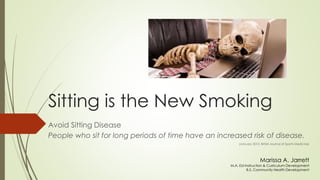
Sitting disease
- 1. Sitting is the New Smoking Avoid Sitting Disease People who sit for long periods of time have an increased risk of disease. (January 2010, British Journal of Sports Medicine) Marissa A. Jarrett M.A. Ed-Instruction & Curriculum Development B.S. Community Health Development
- 2. Sitting Disease Medical experts have started to refer to long periods of physical inactivity and its negative consequences as “Sitting Disease.” Obesity Depression Anxiety Cardiovascular Disease Diabetes High Blood Pressure Cancer Stroke If you are sedentary for more than 4 hours/day you may be at risk for these health risks.
- 3. Statistics 126,216 individuals (69, 776 women and 53,440 men) from 1993-2006 were followed in a study published in the American Journal of Epidemiology: Women who were inactive and sat over 6 hours a day were 94% more likely to die during the time period studied than those who were physically active and sat less than 3 hours a day. Men were 48% more likely to die than their standing counterparts.
- 4. Don‘t be an active couch potato According to a report by the University of Queensland, Australia, School of Population Health: “Even when adults meet physical activity guidelines, sitting for prolonged periods can compromise metabolic health”(Thinline 2017, p. 25).
- 5. A little history. . . For most of human history we were hunters & gatherers. Hunter-gatherers would walk or run 6-12 miles a day. Several thousand years ago man began farming, raised crops and kept animals. Farming required manual labor and burned many calories per day. 2017 Office-Ergo
- 6. A little history… In the late 18th century, the industrial revolution began and machines replaced many manual tasks. Mechanical assistance greatly reduced the amount of physical activity in our daily lives. Very recently computers became more common in the workplace. Working on a computer all day is very sedentary and is associated with the factors that make up sitting disease. 2017 Office-Ergo
- 7. Did you know. . . Sitting puts your metabolism to sleep. 60- 90 minutes of inactivity is enough to shut down the enzymes responsible for producing HDL – the “good” cholesterol, and for regulating blood sugar. Chronic inactivity is now thought to contribute to our diabetes epidemic. Conversely, during this same period, consuming a fructose based product is responsible for the formation of LDL – the “bad” cholesterol. 2017 Office-Ergo
- 8. Did you know… Sitting tenses the hamstrings and causes a flattening of normal curve in the low back. This distortion of the spine increases the internal strain of the back. Sitting upright or sitting in a forward bent position is particularly hard on the back. Lordosis: flattening of the lower back and resulting pelvic tilt. 2017 Office-Ergo
- 9. Did you know… An hour of daily exercise won’t counteract the negative health effects of sitting. Running, biking and other types of exercise are great for improving fitness, but they don’t counteract the negative health effects of prolonged sitting. 2017 Office-Ergo
- 10. Avoid Crossing Your Legs The heart does not pump back to itself from the lower body. Sitting for a prolonged period of time causes blood to pool in the legs. Move your legs so the muscles can squeeze the veins (peristalsis) to move blood back to the heart. Crossing your legs usually results in pelvic tilt which results in lower back pa
- 11. Tips Take the stairs Walk to and from the parking lot Stand up & move at least once every 30 minutes Walk on your breaks & lunch Keep your feet elevated Refill your water glass/bottle every hour Fill water bottles and use them as hand weights Find a buddy to keep you accountable Flex each muscle group independently while at your desk Walk around the floor on the way to and from your desk
- 12. What’s in it for me? Personal health benefits Better communication/interactions Better focus Longer lifespan Reduce risk of all disease Improved metabolism Improved immune response Decrease risk for dementia & Alzheimer's Opportunity to avoid negative impacts of prolonged sitting
- 13. Fitness Activities Squats: Between calls stand up & sit down aim for 10-20 times Leg extensions: While sitting (raise chair so legs can come under seat then extend and squeeze legs out in front of you) Calf Raises Stand & do a knee curl (bring your heel to your glutes) Fidget Step side to side Using water bottles as hand weights Bicep Curls Lateral Raises Shoulder Presses Tricep extensions Back row Cross punches Bent over raises
- 14. Ergonomics
